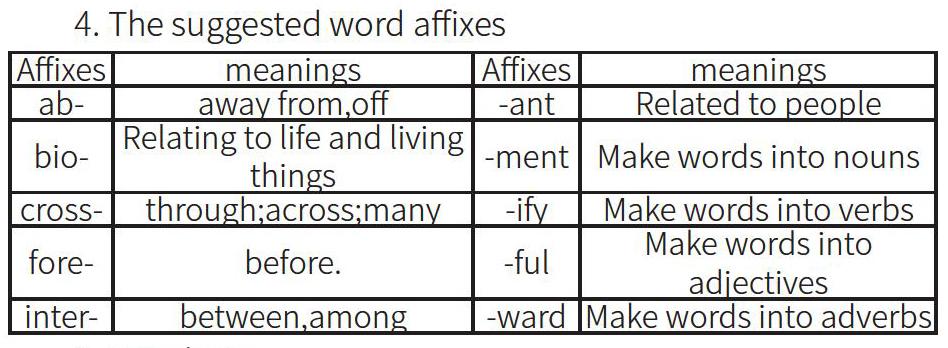Affixes Implications
2019-10-21ZhouFenghan
Zhou Fenghan

1. Introduction
Words are the basic foundation of a sentence, and as it is defined by Jensen (1990): “a study of the internal structure of it is called morphology”(p.1). The study of morphology can help learners have a better understanding of words in a second language and as well as English translation works. This article will study on the aspect of affixes in morphology, and find the pedagogical implications of affixes in morphology.
2. Affixes and its insights
Morphemes are the fundamental elements of words, they are typical but not necessarily meaningful this idea was given by Jensen. Prefixes and suffixes are the branches of affixes which is a part of morphemes that is different from the free ones or the root, which carries a meaning. This article will many focus on the affixes in morphology, which can be understand literally as “attached to”(Jensen, 1990). As Carstairs (2002) defined that: “Only root morphemes can be free, so affixes are necessarily bound”.
Knowing how to enlarge and memorize vocabulary can be a basic skill for learning English and English translation. As Mochizuki and Aizawa(2000) described the relationship of affixes and vocabulary, that the knowledge of affix is very important for the researchers and practitioners, because it might lead the learners to process of vocabulary acquisition that plays an important role in reading and comprehension.
The most commonly used prefixes like “un-” and “dis-”, which have a meaning of the opposite to the following words, for example “unfamiliar” and “dislike”, which is just the opposite meaning of the word “familiar” and “like”. The basic knowledge of affixes can enlarge ones vocabulary.
Another function of affixes is that it may indicate the word class. This part is quite useful for bilingual translations. The suffixes like “-er”, “-ance”, “-or” usually representing the nouns, such as “teacher” which is a noun of “teach”. This kinds of affixes functions in categorizing word class can help the learners understand the structure of a sentence better. This is the case especially for EFL learners and in this case it will be easier for them to get the meanings of a sentence.
3. Using affixes for pedagogical purpose
In the aspect of morphology important differences exist between English and Chinese. For English the main method of word formation is inflections and derivations, while more than 75% of Chinese words are compounding words in terms of word formation (Kuo & Anderson, 2006; Sun, Sun, Huang, Li & Xing, 1996). The compares between the Chinese and English study will help teachers find some easy and acceptable figures from Chinese and then put them into English language teaching and certain Chinese and English translations.
Teachers may first categorize the commonly used prefixes and its suggested functions in the meaning of one word, and then giving the classes. Before giving the classes, teacher can define a theme of one lesson. For example, the prefixes like “dis-”, “ab-”, “de-” and “non-” are inferring the apposite meaning or deny the word that followed it. In this case, teachers can give this part as the “deny part of prefixes”, and then give a list of words about 20, like “dislike, disable, abnormal, non-harmful, denature”, the words that giving should contained the morphemes that concentrate on the “deny part of prefixes”.
Here we focus on the suffixes that could change the word class, and have some syntactic contributions to the sentences. Suffixes like “-am”, “-ant”, “-er”and “-ar” are normally related to the nouns, they can make a word into a noun. Categorizing suffixes according to the word class aspect is not the only way of learning it, other ways of grouping them can also be put into use.
4. The suggested word affixes
5. Conclusion
Prefix and suffix are the branches of affix that are different from the root, they can not stand on its own in order to make a meaning. They are very productive in producing words. Having the basic knowledge of affixes will do a lot of help to Chinese EFL learners and translation works. What is more, some word classes have been changed when the affixes is added in one word, the change and the position of word classes in one sentence can help learners understand the English sentences better. Practical practice should follow up when finishing the affixes teaching, the practice method that have been provided is only a suggestion. There are still more to investigate since the focuses of this article is limited to certain aspects.
References:
[1]Green, J. D.. Language detectives: Teaching and learning about suffixes[J]. The Reading Teacher,2015,68(7):539.
【作者簡介】Zhou Fenghan, Bozhou Vocational and Technological College.
【基金项目】Topic: The Translation studies of Bozhou Huaxilou Project (No. BYK1764).
